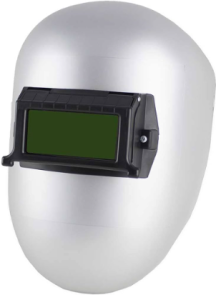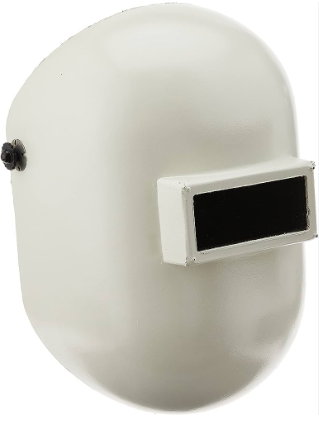Pipeliner Welding Hood
In the realm of welding, precision, safety, and comfort are paramount. A welder’s hood is not just a protective accessory; it’s a crucial tool that can make the difference between a job well done and a potential hazard. Among the various welding hoods available in the market, the Pipeliner Welding Hood has risen to prominence as a favored choice among professionals who seek the perfect balance between functionality, durability, and comfort.
Unveiling the Essence of a Pipeliner Welding Hood:
The Pipeliner Welding Hood is not merely a piece of equipment; it’s a testament to the evolution of welding technology and the continuous pursuit of excellence. Originally designed for pipeline welders, this hood has transcended its original purpose and become a symbol of superior craftsmanship. Its distinctive circular lens, compact design, and durable construction make it a staple in the toolkit of many skilled welders.
1. Precision through Design:
At the heart of every great welding hood is the lens, and the Pipeliner Hood boasts a circular lens that offers a unique advantage. Unlike rectangular lenses found in many other hoods, the circular lens minimizes distortion and offers a broader and clearer field of vision. This design is particularly advantageous for welders who need to maintain focus on intricate welds and follow precise guidelines. The lens is often treated to resist scratches and impacts, ensuring longevity without compromising visibility.
2. Durability Beyond Measure:
Pipeline welders work in some of the harshest conditions, exposing their equipment to extreme temperatures, debris, and mechanical stress. The Pipeliner Welding Hood is built to withstand these challenges. Constructed from rugged materials such as heat-resistant plastics and metals, it is designed to be not only impact-resistant but also capable of enduring prolonged exposure to heat without losing its structural integrity. This durability factor ensures that welders can rely on their Pipeliner Hood to stand the test of time, no matter the conditions.
3. Comfort for Extended Productivity:
Welding is a demanding profession that often requires extended periods of focused work. The comfort of the equipment worn can significantly impact a welder’s ability to perform optimally. The Pipeliner Welding Hood excels in this aspect as well. Its lightweight design, coupled with adjustable headgear and a secure fit, ensures that the hood stays comfortably in place throughout long work sessions. This eliminates the need for constant readjustments, allowing welders to maintain their concentration and complete their tasks efficiently.
4. Adaptability and Customization:
Welding is a diverse field with a range of techniques and applications. The Pipeliner Welding Hood acknowledges this diversity by offering adaptability and customization options. Welders can choose from various lens shades, allowing them to tailor the hood to the specific welding process they are undertaking. Whether it’s shielded metal arc welding (SMAW), gas metal arc welding (GMAW), or flux-cored arc welding (FCAW), the Pipeliner Hood can be adjusted to ensure optimal visibility and protection.
5. A Legacy of Reliability:
The popularity of the Pipeliner Welding Hood is not solely based on its technical attributes; it’s also a result of the legacy it carries. Seasoned welders often pass down their Pipeliner Hoods to the next generation, a testament to its enduring quality. This sense of reliability and trust in the equipment creates a sense of camaraderie among welders, forming a bond that transcends time and generations.
6. Evolving with Technology:
While the classic design and core features of the Pipeliner Welding Hood remain steadfast, it has also evolved with the integration of modern technology. Some models now incorporate auto-darkening lenses, which adjust the shade level in response to the welding arc’s brightness. This innovation enhances both convenience and safety, ensuring that the welder’s eyes are adequately protected without the need for manual adjustments.
Selecting the Perfect Pipeliner Welding Hood: A Comprehensive Guide
Pipeliner welding hoods are essential tools for welders working in the pipeline industry. They offer protection from harmful welding arcs and debris, ensuring welders’ safety and performance. Choosing the best pipeliner welding hood requires careful consideration of various factors to ensure comfort, visibility, and durability. This guide outlines key features and considerations to help you make an informed decision.

Safety and Certification:
Prioritize hoods that meet industry safety standards and certifications, such as ANSI Z87.1 for eye and face protection. Look for hoods with a high Ultraviolet Protection Factor (UPF) rating to safeguard against harmful UV rays.
Lens Shade and Auto-Darkening:
Opt for a hood with adjustable lens shades, as different welding processes require varying levels of darkness. Auto-darkening hoods are popular for their convenience, as they automatically adjust to the appropriate shade level when the welding arc is struck.
Viewing Area:
A larger viewing area allows for better visibility of the welding process. Look for a hood that provides ample space without compromising safety.
Arc Sensors:
Hoods with multiple arc sensors offer enhanced sensitivity to light changes, ensuring quick and reliable auto-darkening reactions even when the welding arc is partially obstructed.
Reaction Time:
The reaction time of the auto-darkening feature should be swift to protect your eyes from sudden bursts of intense light.
Comfort and Fit:
A comfortable and well-fitting hood enhances productivity. Adjustable headgear, padded sweatbands, and a lightweight design contribute to prolonged comfort during long welding sessions.
Durability and Materials:
Select a hood constructed from high-quality materials like heat-resistant polycarbonate, strong plastics, and durable metals. This ensures your hood can withstand the rigors of pipeline welding environments.

Respiratory Compatibility:
If you’re using a respirator, ensure the hood’s design accommodates it without compromising the seal, protecting you from fumes and particles.
Battery Life and Power Source:
For auto-darkening hoods, consider the battery life and type. Some models offer solar-assisted batteries for extended use.
Adjustability and Customization:
Look for hoods with adjustable settings for sensitivity, delay, and shade level to fine-tune the hood’s performance according to your welding style and environment.
Brand Reputation and Reviews:
Research reputable brands known for producing high-quality welding hoods. Read user reviews and seek recommendations from experienced welders.
Price vs. Value:
While cost is a factor, prioritize value over price alone. Investing in a reliable, comfortable, and durable hood will pay off in the long run through improved safety and productivity.
In Conclusion:
The Pipeliner Welding Hood stands as a testament to the welding community’s dedication to excellence. Its precision design, durability, comfort, and adaptability make it a coveted choice for both seasoned professionals and newcomers to the field. With its origins rooted in the challenging world of pipeline welding, it has transcended its initial purpose to become an iconic and reliable companion for welders across various applications. The legacy of the Pipeliner Hood continues to thrive as a symbol of quality and craftsmanship in the world of welding—a constant reminder that, in the hands of a skilled welder, the pursuit of perfection knows no bounds.
FAQs about the Best Pipeliner Welding Hood
What is a Pipeliner Welding Hood, and why is it considered the best for pipeline welding?
A Pipeliner Welding Hood is a type of welding helmet designed specifically for pipeline welding applications. It is often considered the best choice due to its compact design, lightweight construction, and specialized features that cater to the unique requirements of welding in confined spaces and on pipelines. These hoods typically offer enhanced visibility, durability, and comfort, making them a preferred choice among pipeline welders.
What features should I look for when selecting the best Pipeliner Welding Hood?
When choosing the best Pipeliner Welding Hood, consider features like a compact profile for easy maneuverability in tight spaces, a comfortable headgear system that minimizes strain during extended use, a high-quality lens with variable shade settings for optimal visibility, and durable construction materials to withstand the rugged conditions of pipeline welding. Additionally, adjustable straps, a sweatband, and lens replacement options are also important factors to consider.
How does the lens technology impact the effectiveness of a Pipeliner Welding Hood?
Lens technology plays a crucial role in the effectiveness of a Pipeliner Welding Hood. Look for hoods that feature auto-darkening lenses with adjustable shades. These lenses protect your eyes by automatically adjusting the shade level based on the welding process and brightness. Some advanced models might also offer true color technology that provides a more natural view of the welding area, enhancing accuracy and reducing eye strain.
Are there any specific safety standards or certifications I should look for in a Pipeliner Welding Hood?
Yes, it’s essential to choose a Pipeliner Welding Hood that meets relevant safety standards and certifications. Look for hoods that comply with ANSI Z87.1 standards for eye and face protection. Additionally, some hoods might also have certifications for impact resistance and welding-specific standards to ensure they provide adequate protection against sparks, UV radiation, and other hazards associated with welding.
Can I use a Pipeliner Welding Hood for other welding applications beyond pipelines?
While Pipeliner Welding Hoods are specifically designed for pipeline welding, their features can make them suitable for other welding applications as well. However, keep in mind that their compact design and specific features might not be ideal for all welding scenarios. If you frequently work on various types of welding projects, you might want to consider a more versatile welding helmet that can accommodate a wider range of welding techniques and environments.
